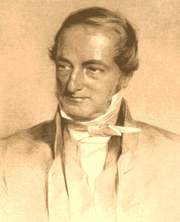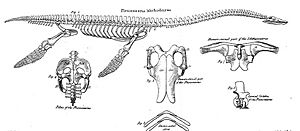William Conybeare (geologist) facts for kids
William Daniel Conybeare (born June 7, 1787 – died August 12, 1857) was an English scientist. He was a geologist, a palaeontologist (someone who studies fossils), and also a clergyman (a church leader). He is most famous for his amazing work with fossils in the 1820s. He wrote important papers about the bones of ichthyosaurs and was the first to scientifically describe a plesiosaur.
Contents
William Conybeare's Life and Work
Early Life and School
William Conybeare was born in London. His grandfather, John Conybeare, was a well-known bishop. William went to Westminster School in London. After that, he studied at Christ Church, Oxford University in 1805. He earned his first degree in 1808. He was very good at classics (like ancient Greek and Roman studies) and mathematics.
Becoming a Church Leader
After finishing university, William Conybeare became a clergyman. In 1814, he worked as a curate (a church assistant) in Wardington. He also taught at Brislington. He helped start the Bristol Philosophical Institution in 1822. Later, he became a rector (a main church leader) in Sully and then a vicar in Axminster. In 1845, he became the dean of Llandaff, which is a very important church role.
His Passion for Geology
William Conybeare became very interested in geology after listening to lectures by Dr. John Kidd. Geology is the study of Earth's history, rocks, and landforms. He loved the subject and traveled a lot around Britain and Europe to study it. He was one of the first members of The Geological Society. Other famous geologists, like William Buckland and Adam Sedgwick, said that Conybeare taught them a lot when they first started studying geology.
Discovering Ancient Sea Creatures
Conybeare wrote many important articles about geology. In 1821, he worked with Henry De la Beche. They described a new type of ancient sea reptile called a Plesiosaurus. They did this by looking at only a few bone pieces! Their paper also gave a lot of information about the bones of ichthyosaurs, another type of ancient sea reptile. They even figured out there were at least three different kinds of ichthyosaurs.
Conybeare's ideas about the plesiosaur were proven right in 1823. A fossil hunter named Mary Anning found a nearly complete plesiosaur skeleton. Conybeare then described this amazing discovery to the Geological Society in 1824.
He also wrote about the River Thames valley and a huge landslide that happened near Lyme Regis in 1839.
Important Geology Book
His most important book was Outlines of the Geology of England and Wales, published in 1822. He wrote it with William Phillips. Conybeare's parts of the book were the most important. This book had a big impact on how geology was studied in Britain. It showed how much he knew about the Earth's history.
William Conybeare was a member of the fellow of the Royal Society. This is a very respected group of scientists. In 1844, he received the Wollaston medal from the Geological Society of London. This medal is a very high honor for geologists. His older brother, John Josias Conybeare, was also interested in geology.
Later Life and Death

In July 1857, William Conybeare became ill while traveling to see his oldest son, William John Conybeare, who was also very sick. His son passed away, and William Conybeare himself died shortly after, on August 12, 1857. He was in Itchen Stoke, where another of his sons was a church leader.
He is buried near the Chapter House at Llandaff Cathedral. His grave is marked by a cross on a tall memorial.
Images for kids
-
William Conybeare's grave and memorial at Llandaff Cathedral.






